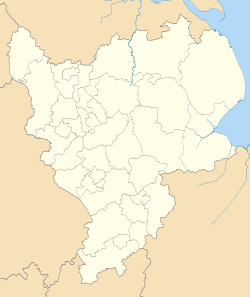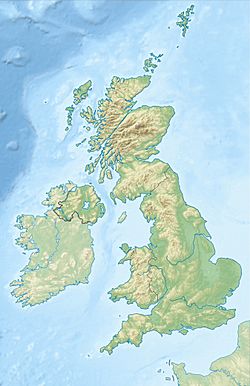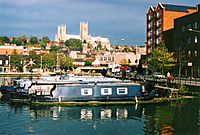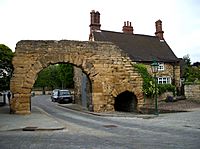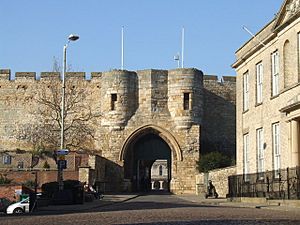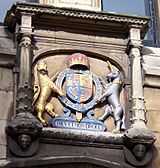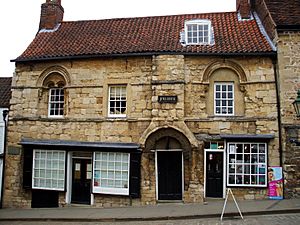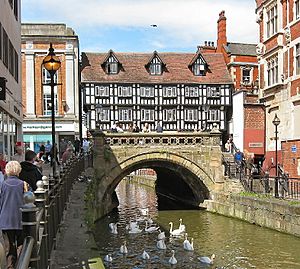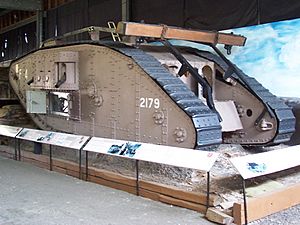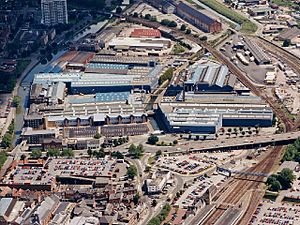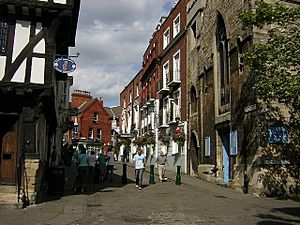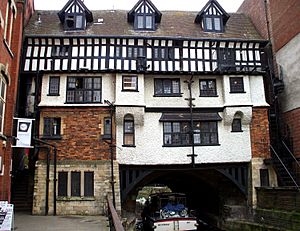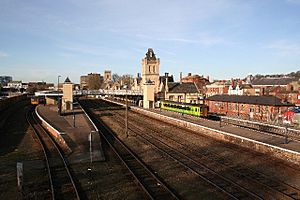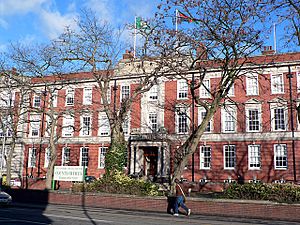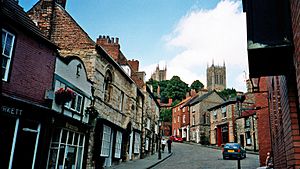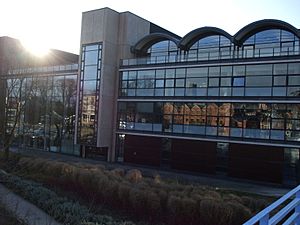Lincoln, England facts for kids
Quick facts for kids
Lincoln
|
|||
|---|---|---|---|
|
City and non-metropolitan district
|
|||
| City of Lincoln | |||
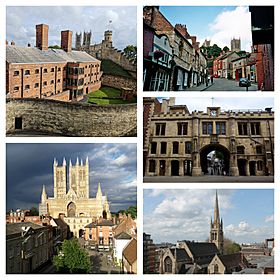
Clockwise from top right: Steep Hill; Guildhall; St Swithin's Church; Lincoln Cathedral; Lincoln Castle
|
|||
|
|||
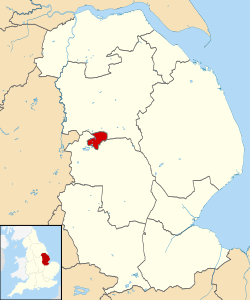
Shown within Lincolnshire
|
|||
| Sovereign state | United Kingdom | ||
| Country | England | ||
| Region | East Midlands | ||
| Ceremonial county | Lincolnshire | ||
| City status | 1072 | ||
| Incorporated | 1 April 1974 | ||
| Administrative centre | Guildhall and Stonebow | ||
| Government | |||
| • Type | Non-metropolitan district | ||
| • Body | City of Lincoln Council | ||
| Area | |||
| • City and borough | 13.78 sq mi (35.69 km2) | ||
| Population
(2005 est.)
|
|||
| • City and borough | 97,541 | ||
| • Rank | 245th (of 326) | ||
| • Density | 1,780/sq mi (687/km2) | ||
| • Urban | 130,200 | ||
| • Metro | 189,000 | ||
| • Ethnicity | 95.6% White 0.8% Asian 0.8% Irish 0.5% Chinese 0.5% African |
||
| Demonym(s) | Lincolnian | ||
| Time zone | UTC+0 (Greenwich Mean Time) | ||
| • Summer (DST) | UTC+1 (British Summer Time) | ||
| Postcode areas |
LN
|
||
| Dialling codes | 01522 | ||
| ONS code | 32UD (ONS) E07000138 (GSS) |
||
| OS grid reference | SK9771 | ||
| Primary airports | Humberside Airport, East Midlands Airport, Doncaster Sheffield Airport | ||
| Councillors | 33 | ||
| Member of Parliament | Karl McCartney (Con) | ||
| City of Lincoln Council | |
|---|---|
 |
|
| Type | |
| Type |
Non-metropolitan district council
|
| History | |
| Founded | 1 April 1974 |
| Leadership | |
|
Leader of the Council
|
Ric Metcalfe
|
| Structure | |
| Seats | 33 councillors |
 |
|
|
Political groups
|
|
|
Length of term
|
4 years |
| Elections | |
|
Last election
|
6 May 2021 |
| Meeting place | |
 |
|
| Guildhall and Stonebow | |
| Website | |
| https://www.lincoln.gov.uk/ | |
Lincoln is a cathedral city, non-metropolitan district, and the county town of Lincolnshire, England. The Lincoln district had a 2012 population of 94,600. The 2011 census gave the urban area of Lincoln, including North Hykeham and Waddington, a population of 115,000. Roman Lindum Colonia developed from an Iron Age settlement on the River Witham. Landmarks include Lincoln Cathedral – English Gothic architecture, for over 200 years the world's tallest building – and the 11th-century Lincoln Castle. The city hosts the University of Lincoln, Bishop Grosseteste University, Lincoln City FC and Lincoln United FC. Lincoln is the largest settlement in Lincolnshire with the towns of Grimsby second largest and Scunthorpe third.
Contents
History
Earliest history: Lincoln
The earliest origins of Lincoln can be traced to the remains of an Iron Age settlement of round wooden dwellings (which were discovered by archaeologists in 1972) that have been dated to the 1st century BC. This settlement was built by a deep pool (the modern Brayford Pool) in the River Witham at the foot of a large hill (on which the Normans later built Lincoln Cathedral and Lincoln Castle).
The origins of the name Lincoln may come from this period, when the settlement is thought to have been named in the Brythonic language of Iron Age Britain's Celtic inhabitants as Lindon "The Pool", presumably referring to Brayford Pool (compare the etymology of the name Dublin, from the Gaelic dubh linn "black pool"). The extent of this original settlement is unknown as its remains are now buried deep beneath the later Roman and medieval ruins and modern Lincoln.
Roman history: Lindum Colonia
The Romans conquered this part of Britain in AD 48 and shortly afterwards built a legionary fortress high on a hill overlooking the natural lake formed by the widening of the River Witham (the modern day Brayford Pool) and at the northern end of the Fosse Way Roman road (A46). The Celtic name Lindon was subsequently Latinised to Lindum and given the title Colonia when it was converted into a settlement for army veterans.
The conversion to a colonia was made when the legion moved on to York (Eboracum) in AD 71. Lindum colonia or more fully, Colonia Domitiana Lindensium, after its founder Domitian, was established within the walls of the hilltop fortress with the addition of an extension of about equal area, down the hillside to the waterside below.
It became a major flourishing settlement, accessible from the sea both through the River Trent and through the River Witham. On the basis of the patently corrupt list of British bishops who attended the 314 Council of Arles, the city is now often considered to have been the capital of the province of Flavia Caesariensis which was formed during the late-3rd century Diocletian Reforms. Subsequently, however, the town and its waterways fell into decline. By the close of the 5th century the city was largely deserted, although some occupation continued under a Praefectus Civitatis, for Saint Paulinus visited a man of this office in Lincoln in AD 629.
AD 410–1066
During this period the Latin name Lindum Colonia was shortened in Old English to become first Lindocolina, then Lincylene.
After the first destructive Viking raids, the city once again rose to some importance, with overseas trading connections. In Viking times Lincoln was a trading centre that issued coins from its own mint, by far the most important in Lincolnshire and by the end of the 10th century, comparable in output to the mint at York. After the establishment of the Danelaw in 886, Lincoln became one of the Five Boroughs in the East Midlands. Excavations at Flaxengate reveal that this area, deserted since Roman times, received new timber-framed buildings fronting a new street system in about 900. Lincoln experienced an unprecedented explosion in its economy with the settlement of the Danes. Like York, the Upper City seems to have been given over to purely administrative functions up to 850 or so, while the Lower City, running down the hill towards the River Witham, may have been largely deserted. By 950, however, the banks of the Witham were newly developed with the Lower City being resettled and the suburb of Wigford quickly emerging as a major trading centre. In 1068, two years after the Norman conquest, William I ordered Lincoln Castle to be built on the site of the former Roman settlement, for the same strategic reasons and controlling the same road.
Cathedral
Construction of the first Lincoln Cathedral, within its close or walled precinct facing the castle, began when the see was removed from the quiet backwater of Dorchester-on-Thames, Oxfordshire, and was completed in 1092; it was rebuilt after a fire but was destroyed by an unusual earthquake in 1185. The rebuilt Lincoln Minster, enlarged to the east at each rebuilding, was on a magnificent scale, its crossing tower crowned by a spire reputed to have been 525 ft (160 m) high, the highest in Europe. When completed the central of the three spires is widely accepted to have succeeded the Great Pyramids of Egypt as the tallest man-made structure in the world.
The Bishops of Lincoln were among the magnates of medieval England: the Diocese of Lincoln, the largest in England, had more monasteries than the rest of England put together, and the diocese was supported by large estates.
When Magna Carta was drawn up in 1215, one of the witnesses was Hugh of Wells, Bishop of Lincoln. One of only four surviving originals of the document is preserved in Lincoln Castle.
Among the most famous bishops of Lincoln were Robert Bloet, the magnificent justiciar to Henry I, Hugh of Avalon, the cathedral builder canonised as St Hugh of Lincoln, Robert Grosseteste, the 13th century intellectual, Henry Beaufort, chancellor of Henry V and Henry VI, Thomas Rotherham, a politician deeply involved in the Wars of the Roses, Philip Repyngdon, chaplain to Henry IV and defender of Wycliffe, and Thomas Wolsey, the lord chancellor of Henry VIII. Theologian William de Montibus was the head of the cathedral school and chancellor until his death in 1213.
The administrative centre was the Bishop's Palace, the third element in the central complex. When it was built in the late 12th century, the Bishop's Palace was one of the most important buildings in England. Built by Hugh of Lincoln, its East Hall range over a vaulted under-croft is the earliest surviving example of a roofed domestic hall. The chapel range and entrance tower were built by Bishop William of Alnwick, who modernised the palace in the 1430s. Both Henry VIII and James I were guests of bishops here; the palace was sacked by royalist troops during the civil war in 1648.
Following a recent break-in, some of the stained glass windows of the cathedral have had to be replaced.
Medieval town
During the Anarchy, in 1141 Lincoln was the site of a battle between King Stephen and the forces of Empress Matilda, led by her illegitimate halfbrother Robert, 1st Earl of Gloucester. After fierce fighting in the city's streets, Stephen's forces were defeated. Stephen himself was captured and taken to Bristol.
By 1150, Lincoln was among the wealthiest towns in England. The basis of the economy was cloth and wool, exported to Flanders; Lincoln weavers had set up a guild in 1130 to produce Lincoln Cloth, especially the fine dyed 'scarlet' and 'green', the reputation of which was later enhanced by Robin Hood wearing woollens of Lincoln green. In the Guildhall that surmounts the city gate called the Stonebow, the ancient Council Chamber contains Lincoln's civic insignia, a particularly fine collection of civic regalia.
Outside the precincts of cathedral and castle, the old quarter clustered around the Bailgate, and down Steep Hill to the High Bridge, which bears half-timbered housing, with the upper storeys jutting out over the river. There are three ancient churches: St Mary le Wigford and St Peter at Gowts are both 11th century in origin and St Mary Magdalene, built in the late 13th century, is an unusual English dedication to the saint whose cult was coming greatly into vogue on the European continent at that time.
Lincoln was home to one of the five most important Jewish communities in England, well established before it was officially noted in 1154. In 1190, anti-Semitic riots that started in King's Lynn, Norfolk, spread to Lincoln; the Jewish community took refuge with royal officials, but their habitations were plundered. The so-called House of Aaron has a two-storey street frontage that is essentially 12th century and a nearby Jew's House likewise bears witness to the Jewish population. In 1255, the affair called 'The Libel of Lincoln' in which prominent Jews of Lincoln, accused of the ritual murder of a Christian boy ('Little Saint Hugh of Lincoln' in medieval folklore) were sent to the Tower of London and 18 were executed. The Jews were expelled en masse in 1290.
During the 13th century, Lincoln was the third largest city in England and was a favourite of more than one king. During the First Barons' War, it became caught up in the strife between the king and the rebel barons, who had allied with the French. It was here and at Dover that the French and Rebel army was defeated. In the aftermath of the battle, the town was pillaged for having sided with Prince Louis.
According to some historians, the city's fortunes began to decline during the 14th century, although this assertion has been disputed, it being argued that the city remained buoyant in both trade and communications well into the 15th century. Thus in 1409, the city was made a county in its own right known as the County of the City of Lincoln. Thereafter, various additional rights being conferred on the town by successive monarchs, including those of an assay town (which controlled metal manufacturing, for example). The oldest surviving secular drama in English, The Interlude of the Student and the Girl (c. 1300), may have originated from Lincoln.
16th century
The Dissolution of the Monasteries exacerbated Lincoln's problems, cutting off its main source of diocesan income and drying up the network of patronage controlled by the bishop, with no fewer than seven monasteries closed within the city alone. A number of nearby abbeys were also closed, which led to further diminution of the region's political power. When the cathedral's great spire rotted and collapsed in 1549 and was not replaced, it was a significant symbol of Lincoln's economic and political decline. However, the comparative poverty of post-medieval Lincoln preserved pre-medieval structures that would probably have been lost under more prosperous conditions.
Civil War
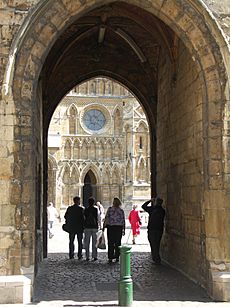
Between 1642 and 1651, during the English Civil War, Lincoln was on the frontier between the Royalist and Parliamentary forces and changed hands several times. Many buildings were badly damaged. Lincoln now had no major industry and no easy access to the sea and was poorly situated. Thus while the rest of the country was beginning to prosper at the beginning of the 18th century, Lincoln suffered immensely, travellers often commenting on the state of what had essentially become a one-street town.
Georgian Age
By the Georgian era, Lincoln's fortunes began to pick up, thanks in part to the Agricultural Revolution. The re-opening of the Foss Dyke canal allowed coal and other raw materials vital to industry to be more easily brought into the city.
As well as the economic growth of Lincoln during this era, the city boundaries expanded to include the West Common. To this day, an annual Beat the Boundaries walk takes place along the perimeter of the common.
Industrial Revolution
Coupled with the arrival of the railway links, Lincoln boomed again during the Industrial Revolution, and several world-famous companies arose, such as Ruston's, Clayton's, Proctor's and William Foster's. Lincoln began to excel in heavy engineering, building locomotives, steam shovels and all manner of heavy machinery.
A permanent military presence was established in the city with the completion of the "Old Barracks" (now the Museum of Lincolnshire Life) in 1857; these were replaced by the "New Barracks" (now Sobraon Barracks) in 1890.
20th century
Lincoln was hit by a major typhoid epidemic between November 1904 and August 1905 caused by polluted drinking water from Hartsholme Lake and the River Witham. Over 1,000 people contracted the disease and fatalities totalled 131, including the very man responsible for the city's water supply, Liam Kirk of Baker Crescent. Near the beginning of the epidemic, Dr. Alexander Cruickshank Houston installed a chlorine disinfection system just ahead of the poorly operating slow sand filter to kill the bacteria causing the epidemic. Chlorination of the water supply continued until 1911 when a new water supply was implemented. The Lincoln chlorination episode was one of the first uses of the chemical to disinfect a water supply. Westgate Water Tower was constructed to provide new water supplies to the city.
In the two world wars, Lincoln switched to war production. The first ever tanks were invented, designed and built in Lincoln by William Foster & Co. during the First World War and population growth provided more workers for even greater expansion. The tanks were tested on land now covered by Tritton Road (in the south-west suburbs of the city). During the Second World War, Lincoln produced a vast array of war goods, from tanks, aircraft, munitions and military vehicles.
Ruston & Hornsby produced diesel engines for ships and locomotives, then by teaming up with former colleagues of Frank Whittle and Power Jets Ltd, in the early 1950s, R & H (which became RGT) opened the first-ever production line to build gas turbine engines for land-based and sea-based energy production. Hugely successful, it was the largest single employer in the city, providing over 5,000 jobs in its factory and research facilities, making it a rich takeover target for industrial conglomerates. It was subsumed by English Electric in November 1966, which was then bought by GEC in 1968, with diesel engine production being transferred to the Ruston Diesels Division in Newton-le-Willows, Lancashire, at the former Vulcan Foundry, which was eventually bought by the German MAN Diesel (now MAN Diesel & Turbo) in June 2000.
It merged with Alstom of France in the late 1980s, then in 2003 was bought out by Siemens AG of Germany, now being called Siemens Industrial Turbomachinery. This also includes what is left of Napier Turbochargers. Plans were announced early in 2008 for the construction of a new plant just outside the city boundary at Teal Park, North Hykeham. Unfortunately Siemens made large scale redundancies and moved jobs to both Sweden and the Netherlands. The factory now employs 1300 people. R&H's former Beevor Foundry is now owned by Hoval Group who make industrial boilers (wood chip). The Aerospace Manufacturing Facility (AMF) at the Firth Road site was divested to ITP Engines UK, in January 2009 from Alstom Aerospace Ltd.
Lincoln's second largest private employer is James Dawson and Son, a belting and hose manufacturer founded in Lincoln in the late 19th century, which is located on the city's Tritton Road next to the University of Lincoln, it still operates using a coal-fired boiler. Dawson's became part of the Hull-based Fenner group in the late 1970s.
In the post-war years after 1945, new suburbs were built, but heavy industry declined towards the end of the 20th century, mimicking the wider economic profile of the United Kingdom. More people are nevertheless still employed today in Lincoln building gas turbines than anything else.
Topography: "Uphill" and "Downhill"
Lincoln is situated in a gap in the Lincoln Cliff (a major escarpment that runs north–south through Lindsey and Kesteven, in central Lincolnshire and rising to 200 feet (61 metres) in height). The River Witham flows through this gap. Lincoln is thus divided informally into two zones, known locally as "Uphill" and "Downhill", with Uphill at 72.8 metres (238.8 feet) above sea level in the area near Lincoln Cathedral, and Downhill at a height of 20.4 metres (66.9 feet) above sea level by the River Witham.
The uphill area comprises the northern part of the city, on top of the Lincoln Cliff (to the north of the gap). This area includes the historical quarter, including Lincoln Cathedral, Lincoln Castle and the Medieval Bishop's Palace, known locally as The Bail (although described in tourist promotional literature as the Cathedral Quarter). It also includes residential suburbs to the north and north-east. The downhill area comprises the city centre (located in the gap) and the suburbs to the south and south-west. The aptly named Steep Hill is a narrow, pedestrian street connecting the two (too steep for vehicular traffic). It passes through an archway known as the Stonebow.
This divide marks out Lincoln from many other historic cities in England and elsewhere in Europe.
The divide was also once an important class distinction, with Uphill more affluent and Downhill less so. This distinction dates from the time of the Norman conquest, when the religious and military elite occupied the hilltop. The construction and expansion of suburbs in both parts of the city since the mid-19th century has diluted this distinction. Nevertheless, Uphill residential property continues to fetch a premium, and is almost invariably referred to as such by local estate agents.
Climate
Like the rest of the British Isles, Lincoln has a maritime climate with cool summers and mild winters. The nearest Met Office weather station is at Waddington, about 4 miles (6 kilometres) to the south of the city centre. Temperature extremes since 1948 have ranged from as high as 34.8 °C (94.6 °F) in August 1990, to as low as −15.6 °C (3.9 °F) in February 1956. A now closed weather station still holds the record for the lowest daytime maximum temperature recorded in England in the month of December: −9.0 °C (15.8 °F) on 17 December 1981. The coldest temperature reported in recent years was −10.4 °C (13.3 °F) during December 2010, although another weather station, at Scampton, a similar distance north of the city centre, fell to −15.6 °C (3.9 °F), thus equalling Waddington's record low set in 1956.
| Climate data for Waddington 68m (223 ft) asl, 1981-2010, extremes 1948- (Weather station 4 miles (6 km) to the south of Lincoln) | |||||||||||||
|---|---|---|---|---|---|---|---|---|---|---|---|---|---|
| Month | Jan | Feb | Mar | Apr | May | Jun | Jul | Aug | Sep | Oct | Nov | Dec | Year |
| Record high °C (°F) | 13.9 (57.0) |
17.4 (63.3) |
22.4 (72.3) |
26.1 (79.0) |
27.8 (82.0) |
32.4 (90.3) |
33.1 (91.6) |
34.8 (94.6) |
30.0 (86.0) |
29.2 (84.6) |
17.8 (64.0) |
15.1 (59.2) |
34.8 (94.6) |
| Average high °C (°F) | 6.6 (43.9) |
7.1 (44.8) |
9.8 (49.6) |
12.5 (54.5) |
15.9 (60.6) |
18.7 (65.7) |
21.3 (70.3) |
21.1 (70.0) |
18.0 (64.4) |
13.9 (57.0) |
9.5 (49.1) |
6.7 (44.1) |
13.5 (56.3) |
| Average low °C (°F) | 1.3 (34.3) |
1.2 (34.2) |
2.9 (37.2) |
4.4 (39.9) |
7.2 (45.0) |
10.2 (50.4) |
12.4 (54.3) |
12.3 (54.1) |
10.3 (50.5) |
7.2 (45.0) |
4.0 (39.2) |
1.7 (35.1) |
6.3 (43.3) |
| Record low °C (°F) | −13.8 (7.2) |
−15.6 (3.9) |
−11.1 (12.0) |
−4.7 (23.5) |
−2.0 (28.4) |
0.0 (32.0) |
3.3 (37.9) |
3.9 (39.0) |
0.0 (32.0) |
−3.2 (26.2) |
−6.7 (19.9) |
−14 (7) |
−15.6 (3.9) |
| Average precipitation mm (inches) | 50.2 (1.98) |
36.8 (1.45) |
41.6 (1.64) |
46.6 (1.83) |
48.1 (1.89) |
57.4 (2.26) |
58.9 (2.32) |
60.3 (2.37) |
53.4 (2.10) |
56.3 (2.22) |
55.5 (2.19) |
49.3 (1.94) |
614.6 (24.20) |
| Mean monthly sunshine hours | 61.8 | 83.2 | 117.0 | 159.6 | 205.6 | 187.5 | 206.5 | 192.7 | 144.2 | 113.3 | 71.5 | 55.4 | 1,598.3 |
| Source 1: Met Office | |||||||||||||
| Source 2: Royal Dutch Meteorological Institute | |||||||||||||
Transport
Rail
Closure of Lincoln St Marks in 1985 left the city with Lincoln Central, soon renamed plain Lincoln, as its one station. Destinations for East Midlands Railway and Northern Trains services from its five platforms include Newark, Sheffield, Leeds, Nottingham, Grimsby and Peterborough. London North Eastern Railway runs services to London King's Cross, calling at Newark, Peterborough and Stevenage.
Road
The city lies on the A57, A46, A15 and A158 roads. These bring high levels of through traffic and as a result the city has had many bypasses built. In the North West is the £19-million A46 bypass opened in December 1985. On 19 December 2020 the £122-million A15 Eastern bypass was completed. A southern bypass formally known as North Hykeham relief road is due to start construction in 2025 and will be the final section of a complete ring road around the city.
Until the 1980s, the only two trunk roads through Lincoln were the A46 and A15, both feeding traffic along the High Street. At the intersection of Guildhall Street and the High Street, these met at the termination of the A57. North of the city centre, the former A15, Riseholme Road, is the B1226, and the old A46, Nettleham Road, the B1182. The early northern inner ring-road, formed of Yarborough Road and Yarborough Crescent, is numbered B1273.
Air
East Midlands Airport, 43 miles from Lincoln, is the main international airport serving the county. It mainly handles European flights with low-cost airlines. Humberside Airport, 29 miles north of Lincoln, is the only airport located in the county. It has a small number of flights mainly to hub airports such as Amsterdam. Doncaster Sheffield Airport also serves Lincoln. It mainly caters to low-cost airlines and lies just outside the East Midlands Region in South Yorkshire.
International relations
Twin towns
Lincoln is twinned with:
|
Economy
Lincoln's economy is based mainly on public administration, commerce, arable farming and tourism, with industrial relics like Ruston (now Siemens) remaining, although many of Lincoln's industrial giants have ceased production, leaving empty industrial warehouse-like buildings. More recently these have become multi-occupied units, with the likes of Lincs FM radio station (in the Titanic Works) and LA Fitness gym taking space. The main employment sectors are public administration, education and health, with 34 per cent of the workforce. Distribution, restaurants and hotels account for 25 per cent.
Like many other cities, Lincoln has a growing IT economy, with many e-commerce mail order companies, along with a plethora of other, more conventional small industrial businesses. One reason behind the University of Lincoln was to increase inward investment and act as a springboard for small firms. Its presence has also drawn more licensed premises to the town centre around the Brayford Pool. A small business unit next door to a university accommodation building, the Think Tank, opened in June 2009.
Extra motorway services are based on Castle Hill; most new UK service areas are built by Swayfields, its parent company. Of the two main electronics firms, Chelmsford-based e2V (Associated Electrical Industries before 1961) is situated between Carholme Road (A57) and the Foss Dyke, next-door to Carholme Golf Club; and Dynex Semiconductor (formerly Marconi Electronic Devices) in Doddington Road (B1190) near the A46 bypass and North Hykeham. Bifrangi, an Italian maker of crankshafts for off-road vehicles using a screw press, is based at the former Tower Works owned by Smith-Clayton Forge Ltd.
Lincoln is the hub for settlements such as Welton, Saxilby, Skellingthorpe and Washingborough, which look to it for most services and employment needs. Added they raise the population to 165,000. Lincoln is the main centre for jobs and facilities in Central Lincolnshire and performs a regional role over much of Lincolnshire and parts of Nottinghamshire. According to a document entitled "Central Lincolnshire Local Plan Core Strategy", Lincoln has a "travel-to-work" area with a population of about 300,000. Its two universities, gained since 1994, contribute to its growth in the services sector. Blocks of flats, restaurants and entertainment venues have appeared. Entertainment venues linked to the universities include The Engine Shed and The Venue Cinema.
In 2021, Lincoln joined the UK's Key Cities network.
Retail parks
Around the Tritton Road (B1003) trading estate, new businesses have begun trading from large units with car parking. Lincoln has a choice of seven large national supermarkets (Tesco, Asda, Sainsbury, Waitrose, Morrisons, Aldi and Lidl).
St Mark's Square complex had a Debenhams as its flagship store until 2021. The accompanying trading estate still has well-known chain stores.
Tourism
The city is a tourist centre for visitors to historic buildings that include the cathedral, the castle and the medieval Bishop's Palace.

The Collection, of which the Usher Gallery is now part, is an important attraction, partly in a purpose-built venue. It currently contains over 2,000,000 objects, and was one of the four finalists for the 2006 Gulbenkian Prize. Any material from official archaeological excavations in Lincolnshire is eventually deposited there. Other attractions include the Museum of Lincolnshire Life and the International Bomber Command Centre.
Tranquil destinations close by are Whisby Nature Reserve and Hartsholme Country Park (including the Swanholme Lakes SSSI), while noisier entertainment can be found at Waddington airfield, Scampton airfield (base of the RAF's Red Arrows jet aerobatic team), the County Showground or the Cadwell Park motor racing circuit near Louth.
Early each December the Bailgate area holds a Christmas Market in and around the Castle grounds, shaped by the traditional German-style Christmas markets, including that of Lincoln's twin town Neustadt an der Weinstrasse. In 2010, for the first time, the event was cancelled due to "atrocious" snowfalls across most of the United Kingdom. It succumbed again in December 2020 due to the COVID-19 pandemic.
Sport
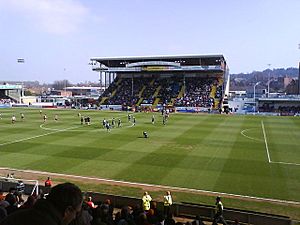
Lincoln's professional football team is Lincoln City FC, nicknamed "The Imps", which plays at the Sincil Bank stadium on the southern edge of the city. The collapse of ITV Digital, which owed Lincoln City FC more than £100,000, in 2002 saw the team faced with bankruptcy, but it was saved by a fund-raising venture among fans, which returned ownership of the club to them, where it has remained since. The club was the first to be relegated from the English Football League, when automatic relegation to the Football Conference was introduced from the 1986–87 season. Lincoln City regained its league place at the first attempt and held onto it until the 2010–11 season, when it was again relegated to the Football Conference.
Lincoln City was the first club managed by Graham Taylor, who went on to manage the English national football team from 1990 to 1993. He was at Lincoln City from 1972 to 1977, during which time the club won promotion from the Fourth Division as champions in 1976. The club also won the Football League Division Three North title on three separate occasions, a joint record. Its most successful era was in the early 1980s, winning promotion from the Fourth Division in 1981 and narrowly missing promotion to the Second Division in the two years that followed. It reached the quarter-finals of the FA Cup in 2017, beating several teams in the top two tiers of English football before being defeated by Arsenal. More recently Lincoln City won Football League Two in the 2018–2019 season and the EFL Trophy in 2018. It is currently managed by Michael Appleton.
Lincoln is also home to Lincoln United FC, Lincoln Moorlands Railway FC and Lincoln Griffins Ladies FC.
Lincoln hosts upcoming sports facilities such American football's Lincolnshire Bombers, which plays in the BAFA National Leagues, the Lincolnshire Bombers Roller Girls, the Imposters Rollergirls, and hosts Lincoln Rowing centre on the River Witham. Lindum Hockey Club plays in the north of the city. Since 1956 the city has played host to the Lincoln Grand Prix one-day cycle race, which for some 30 years has used a city-centre finishing circuit incorporating the challenging 1-in-6 cobbled ascent of Michaelgate. Since 2013 the city has had a professional wrestling promotion and training academy, Lincoln Fight Factory Wrestling. The Lincoln Lions rugby union team has been playing since 1902.
Two short-lived greyhound racing tracks were opened by Lincolnshire Greyhound Racing Association. One was the Highfield track in Hykeham Road, which opened on 13 September 1931, and the second the Lincoln Speedway on the Rope Walk, which opened on 4 June 1932. Racing at both was independent, as they were "flapping" tracks unaffiliated to the sport's governing body, the National Greyhound Racing Club.
Education
Higher education
The older of Lincoln's two higher education institutions, Bishop Grosseteste University, was started as a teacher training college linked to the Anglican Church in 1862. During the 1990s it branched out into other subject areas with a focus on the arts and drama. It became a university college in 2006 with degree powers taken over from the University of Leicester. It gained university status in 2012. An annual graduation celebration takes place in Lincoln Cathedral.}
The larger University of Lincoln started as the University of Lincolnshire and Humberside in 1996, when the University of Humberside opened a Lincoln campus next to Brayford Pool. Lincoln School of Art and Design (which was Lincolnshire's main outlet for higher education) and Riseholme Agricultural College, previously been part of De Montfort University in Leicester, were absorbed into the University of Lincoln in 2001, and subsequently the Lincoln campus took priority over the Hull campus.
The name changed to the University of Lincoln in September 2002. In the 2005–2006 academic year, 8,292 full-time undergraduates were studying there. This rose to 11,900.
Further education
Further education in Lincoln is provided by Lincoln College, Lincolnshire's largest education institution with 18,500 students, 2,300 of them full-time. There is a specialist creative college, Access Creative, offering courses in music, media and games design to some 180 students, all full-time.
Schools
The school system in Lincoln is anomalous within Lincolnshire despite being part of the same local education authority (LEA), as most of the county retained the grammar-school system.
In 1952, William Farr School was founded in Welton, a nearby village. Lincoln itself had four single-sex grammar schools until September 1974.
The Priory Academy LSST converted to academy status in 2008, in turn establishing The Priory Federation of Academies. The Priory Witham Academy was formed when the federation absorbed Moorlands Infant School, Usher Junior School and Ancaster High School. The Priory City of Lincoln Academy was formed when the City of Lincoln Community College merged into the federation. Both schools were rebuilt after substantial investment by the federation. Cherry Willingham School joined the federation in 2017, becoming The Priory Pembroke Academy.
The Lincolnshire LEA was ranked 32nd in the country based on its proportion of pupils attaining at least 5 A–C grades at GCSE including maths and English (62.2% compared with a national average of 58.2%).
There are four special-needs schools in Lincoln: Fortuna Primary School (5–11 year olds), Sincil Sports College (11–16), St Christopher's School (3–16) and St Francis Community Special School (2–18).
Notable people
In alphabetical order:
- Aaron of Lincoln (c. 1125–1186) medieval Jewish financier
- Marlon Beresford (born 1969) professional footballer, made over 400 league appearances, trained at Sheffield Wednesday and played for league clubs, notably Burnley, Middlesbrough and Luton Town.
- Gary Blades (born 1980) professional darts player competing in the Professional Darts Corporation
- George Boole (1815–1864) mathematician, developer of Boolean logic, born in Lincoln in 1815
- William Byrd (c. 1539–40 or 1543–1623) composer, organist attached to Lincoln Cathedral from 1563 to 1572
- George Francis Carline (1855–1920) artist, born in Lincoln
- Jamie Clapham (born 1975) former professional footballer, currently a first-team coach at Barnsley FC
- Sam Clucas (born 1990) footballer, who currently plays with Stoke City F.C., was born and attended school in Lincoln.
- Peter Day (born 1947) broadcaster, attended Lincoln Grammar School.
- Penelope Fitzgerald (1916–2000) novelist, biographer, born Penelope Mary Knox in 1916.
- Keith Fordyce (1928–2011) broadcaster, born in Lincoln
- Lee Frecklington (born 1985) footballer, last played for the League One side Lincoln City
- James Hall (historian) (1846–1914) born and raised in Lincoln before leaving for teacher training in 1864, subsequently settled in Cheshire
- Francis Hill (1899–1980) local historian, mayor of Lincoln and Chancellor of the University of Nottingham, born in Lincoln in 1899
- William Hilton RA (1786–1839) portrait and history painter, born in Lincoln
- John Hurt (1940–2017) actor, attended Lincoln School.
- Colonel John Hutchinson (1615–1664) Roundhead politician and signatory to the death warrant of King Charles I, attended Lincoln Free School.
- Benjamin Lany (1591–1675) academic, royal chaplain and religious writer, was Bishop of Lincoln in 1663–1667.
- William Logsdail (1859–1944) painter, born in Lincoln
- Mary Mackie (née Kathleen Mary Whitlam, living) novelist, non-fiction writer, born in Lincoln in the Second World War, attended Lincoln Christ's Hospital High School.
- Karen Maitland (born 1956) English author of medieval thriller fiction
- Neville Marriner (1924–2016) violinist, conductor, founder of the Academy of St Martin in the Fields, born in Lincoln and educated at Lincoln Grammar School
- Ross McLaren (born 1991) actor, born in Lincoln and trained at the Joyce Mason School of Dance.
- Rose Mead (1867–1946) portrait painter, attended Lincoln School of Art.
- Henry Whitehead Moss (1841–1917) born at Lincoln, he went to Lincoln School before attending Shrewsbury School where he became headmaster.
- Paul Palmer (born 1974) swimmer who won an Olympic silver medal at the Atlanta Olympic Games in 1996, was twice a short-course world champion.
- William Pool (c. 1783–1856) maritime inventor, worked in Lincoln in the 1820s and 1830s.
- Thomas Pownall (1722–1805) politician, Governor of the Province of Massachusetts Bay
- Steve Race (1921–2009) musician, broadcaster, host of Radio 4's My Music 1967–1993, was born in Lincoln and attended Lincoln School in 1932–1939.
- Fanny Robertson (1765-1855) actress and theatre owner, manager of The Lincoln Circuit of theatres.
- Charlotte Scott (1858–1931) mathematician, born in Lincoln
- John Taylor (1781–1864) publisher of John Keats and John Clare, attended Lincoln Grammar School.
- William Tritton (1875–1946) Chairman of William Foster & Co. Ltd from 1911 to 1939, directly involved in developing the military vehicle, the tank
- James Ward Usher (1845–1921) jeweller and philanthropist, spent his life in the city.
- William T. Warrener (1861–1934) English painter, born in Lincoln in 1861, attended Lincoln School of Art.
- Juan Watterson (born 1980) Manx politician, Speaker of the House of Keys, studied at the University of Lincoln.
- Victor Wells-Cole (1897–1987) first-class cricketer, British Army officer
Images for kids
See also
 In Spanish: Lincoln (Lincolnshire) para niños
In Spanish: Lincoln (Lincolnshire) para niños




